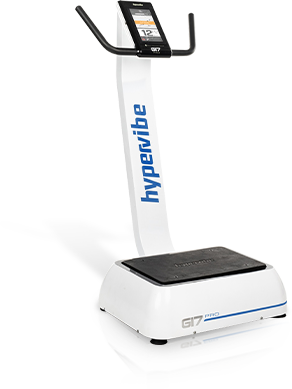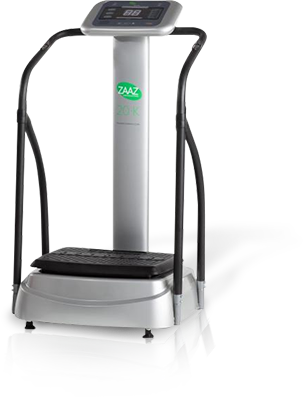

Frequency refers to the number of times per second the platform travels up and down through 1 complete cycle of movement. Research has shown that different vibration frequencies have different effects on the way forces are transmitted to the body. The Zaaz 20K has a maximum frequency of just 15Hz, whereas more than 90% of the 2000+ studies on Whole Body Vibration research use frequency higher than this. If you want to achieve the scientific proven benefits of Whole Body Vibration, it is important the machine you purchase is capable of operating at the same settings used in the scientific research. Scientists have noted that insufficient vibration frequency could be the reason for failed outcomes.
| Frequency Range | |
|---|---|
| Zaaz 20K | 3-15Hz |
| Hypervibe G10 Mini | 5-25Hz |
| Hypervibe G14 Home | 5-30Hz |
| Hypervibe G17 Pro | 5-35Hz |
G force refers to the intensity of the vibration, the more G force placed onto the body, the greater the body responds to that force. The Zaaz 20K has a maximum G force of just 3.5g, whereas Hypervibe machines can be controlled to produce very low G force like Zaaz, or much higher levels of 10g or higher, depending on the model.
When asked why their G force is so low, importers of low G force machines find themselves painted into a corner and respond with the only response available, “high G force is dangerous” and reference the negative effects of G force on fighter pilots (which is trickery and not relevant to G force from vibration).
There is a BIG problem with this response.
There are more than 800 peer reviewed studies on the effects of Whole Body Vibration, and none of those studies used the Zaaz brand. The one machine that has more research than any other brand in the world is called the Galileo, the German inventors of the technology from 1996. Galileo have more than 100 studies published in science journals from around the world, Galileo is the reason why you discovered Zaaz and why you are reading this article right now. The smallest of the Galileo models, is a machine called the “Galileo Kiddy” i.e. it is designed for children. The Galileo Kiddy, has a maximum G force of 10g, whereas their largest model has a maximum G force of more than 30g.
On one hand you have the most scientifically researched machine in the world, inventors of the technology, and their least powerful machine, designed for children produces 10g.
On the other hand, you have the Zaaz machine with no clinical evidence, warning of the dangers of high G force, whilst also referencing the Galileo research on their website as evidence for the benefits of their machine.
The same story repeats again when comparing Zaaz to brands that have been heavily researched.
| G FORCE RANGE | |
|---|---|
| Zaaz 20K | Up to 3.5g |
| Hypervibe G10 Mini | Up to 10g |
| Hypervibe G14 Home | Up to 14g |
| Hypervibe G17 Pro | Up to 17g |
At this point, you might be wondering, what good is a warranty if a product is underpowered?
Well, some are interested in this, so here is how the Zaaz warranty stacks up against the Hypervibe warranty.
| STANDARD WARRANTY | |
|---|---|
| Zaaz | 2 Years Parts & Labour |
| Hypervibe | 2 Years Labour 5 Years Parts 10 Years Motor |
When a company make claims that their product is supported by scientific evidence, it would not be unreasonable to expect such evidence can be provided. There are over 800 scientific studies on Whole Body Vibration, dating back over 20 years, however, not a single one of those studies was performed on the Zaaz machine.
You might think, well it doesn’t really matter what brand of machine was studied, what really matters is that there is scientific proof that Whole Body Vibration works, right?
Well no, when scientists conduct a study, there are many factors they choose which can cause a study to be successful or a study to fail. In Whole Body Vibration research, such factors include, how many times per week they use the machine, what exercises will be performed on the machine, how long each exercise will be performed for, and importantly what vibration settings will be used. If the vibration levels are too low, the forces placed onto the body can be too low to cause any benefits, alternatively, studies have shown that as forces are increased, the response from the body increases. Therefore, if a machine has not been used in scientific research, it is important to make review studies to make sure that the alternative product can produce the same levels of vibration used in the research.

In a 2012 comparison of over 41 different vibration machines, engineering test results showed that on average, the more G force a machine could produce, the more expensive it was.